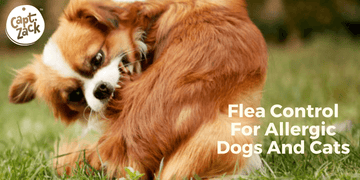For some pets, fleas are just an annoyance. However, for pets with allergies, fleas are a serious problem. In addition to causing severe itching, fleas can also cause other problems such as skin infections and hair loss.
Although flea allergy dermatitis is the most common skin disease of dogs and cats, it can be difficult for some pet owners to suspect fleas as a cause of their pet’s skin problems because they have not seen fleas on their pet. Most flea-allergic pets lick, groom, and chew after being bitten by a flea. This causes the flea to either jump off the pet or be eaten by the pet. For this reason, most dogs and cats with severe flea allergies have never been found with fleas on them!

The Life Cycle of the Flea: Ctenocephalides felis
The majority of the flea population is found off the pet and around the home. Flea eggs are laid in the hair coat and are designed to fall off your pet and into your home. Flea larvae hatch from the eggs and develop in a pet’s environment by feeding on adult flea feces (i.e. digested blood) that fall out of the hair coat of the pet. Flea larvae eventually spin cocoons, often within carpet fibers, for pupation.
The ideal flea control program uses products that target all of the various stages of the flea life cycle and treats the pet’s environment.
Flea Control Recommendations
For the flea allergic patient, 100% flea control is required to remain symptom-free. Even very minimal exposure (i.e. one flea bite a week) may be enough to keep a flea-allergic patient itchy!
- Your pet should remain on monthly flea control year-round. Any pets in contact with that pet should also be on monthly flea control.
-
Your pet’s veterinarian may ask you to treat your pet’s indoor environment for fleas with a spray designed to quickly kill fleas and stop their reproduction. To use a spray around your home:
- Remove your pets from the area to be sprayed.
- Wash all bedding.
- Vacuum all carpets and upholstery and then discard the vacuum bag (flea eggs can continue to hatch in vacuum bags).
- Spray all surfaces until damp to the touch.
- Sometimes a pet’s outdoor environment will also need to be treated for fleas. Your veterinarian can recommend a product for you to use or the outdoor environment can be treated professionally by pest specialists.
Always wait until all surfaces have dried before allowing your pets back into a treated area.

For Flea & Tick Prevention. Check out Captain Zack's VetCare Range!
The articles mentioned here are created from the experience – professional or personal of the contributors themselves. Please do not try anything without consulting your vet first. The views or opinions expressed on this platform belong solely to the contributors.





